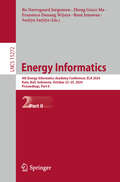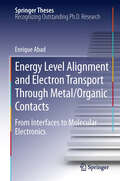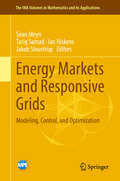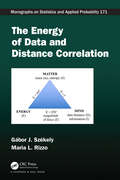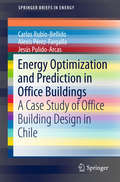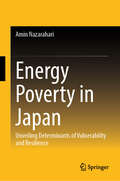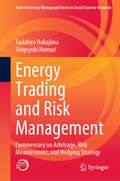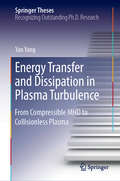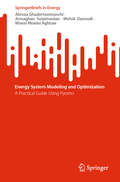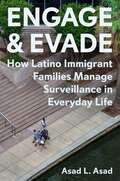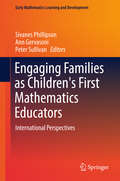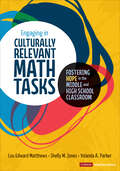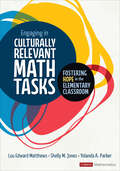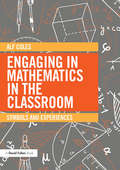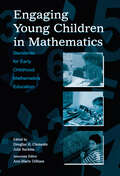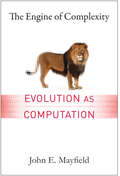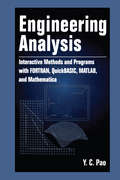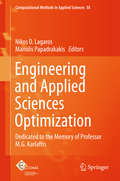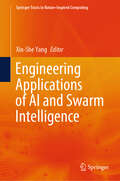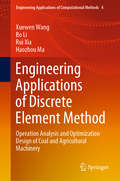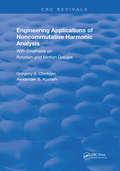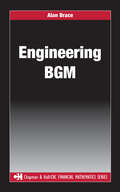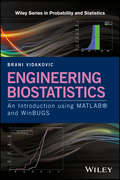- Table View
- List View
Energy Informatics: 4th Energy Informatics Academy Conference, EI.A 2024, Kuta, Bali, Indonesia, October 23–25, 2024, Proceedings, Part II (Lecture Notes in Computer Science #15272)
by Bo Nørregaard Jørgensen Zheng Grace Ma Fransisco Danang Wijaya Roni Irnawan Sarjiya SarjiyaThe two-volume set LNCS 15271 and 15272 constitutes the proceedings of the 4th Energy Informatics Academy Conference, EI.A 2024, held in Kuta, Bali, Indonesia, during October 23–25, 2024. The 40 full papers and 8 short papers included in these proceedings were carefully reviewed and selected from 64 submissions. They are categorized under the topical sections as follows: Part I: IoT Edge Computing, and Software Innovations in Energy, Big Data Analytics and Cybersecurity in Energy, Digital Twin Technology and Energy Simulations, Energy data and consumer behaviors, and Digitalization of District Heating and Cooling Systems. Part II: Smart Buildings and Energy Communities, Energy Pricing, Trading, and Market Dynamics, Demand Flexibility and Energy Conservation Strategies, Optimization of Energy Systems and Renewable Integration and Energy System Resilience and Reliability.
Energy Level Alignment and Electron Transport Through Metal/Organic Contacts
by Enrique AbadIn recent years, ever more electronic devices have started to exploit the advantages of organic semiconductors. The work reported in this thesis focuses on analyzing theoretically the energy level alignment of different metal/organic interfaces, necessary to tailor devices with good performance. Traditional methods based on density functional theory (DFT), are not appropriate for analyzing them because they underestimate the organic energy gap and fail to correctly describe the van der Waals forces. Since the size of these systems prohibits the use of more accurate methods, corrections to those DFT drawbacks are desirable. In this work a combination of a standard DFT calculation with the inclusion of the charging energy (U) of the molecule, calculated from first principles, is presented. Regarding the dispersion forces, incorrect long range interaction is substituted by a van der Waals potential. With these corrections, the C60, benzene, pentacene, TTF and TCNQ/Au(111) interfaces are analyzed, both for single molecules and for a monolayer. The results validate the induced density of interface states model.
Energy Markets and Responsive Grids: Modeling, Control, and Optimization (The IMA Volumes in Mathematics and its Applications #162)
by Sean Meyn Tariq Samad Ian Hiskens Jakob StoustrupThis volume consists of selected essays by participants of the workshop Control at Large Scales: Energy Markets and Responsive Grids held at the Institute for Mathematics and its Applications, Minneapolis, Minnesota, U.S.A. from May 9-13, 2016. The workshop brought together a diverse group of experts to discuss current and future challenges in energy markets and controls, along with potential solutions. The volume includes chapters on significant challenges in the design of markets and incentives, integration of renewable energy and energy storage, risk management and resilience, and distributed and multi-scale optimization and control. Contributors include leading experts from academia and industry in power systems and markets as well as control science and engineering. This volume will be of use to experts and newcomers interested in all aspects of the challenges facing the creation of a more sustainable electricity infrastructure, in areas such as distributed and stochastic optimization and control, stability theory, economics, policy, and financial mathematics, as well as in all aspects of power system operation.
The Energy of Data and Distance Correlation (Chapman And Hall/crc Monographs On Statistics And Applied Probability Ser.)
by Gabor J. Szekely Maria L. RizzoEnergy distance is a statistical distance between the distributions of random vectors, which characterizes equality of distributions. The name energy derives from Newton's gravitational potential energy, and there is an elegant relation to the notion of potential energy between statistical observations. Energy statistics are functions of distances between statistical observations in metric spaces. The authors hope this book will spark the interest of most statisticians who so far have not explored E-statistics and would like to apply these new methods using R. The Energy of Data and Distance Correlation is intended for teachers and students looking for dedicated material on energy statistics, but can serve as a supplement to a wide range of courses and areas, such as Monte Carlo methods, U-statistics or V-statistics, measures of multivariate dependence, goodness-of-fit tests, nonparametric methods and distance based methods. •E-statistics provides powerful methods to deal with problems in multivariate inference and analysis. •Methods are implemented in R, and readers can immediately apply them using the freely available energy package for R. •The proposed book will provide an overview of the existing state-of-the-art in development of energy statistics and an overview of applications. •Background and literature review is valuable for anyone considering further research or application in energy statistics.
Energy Optimization and Prediction in Office Buildings: A Case Study Of Office Building Design In Chile (SpringerBriefs in Energy)
by Carlos Rubio-Bellido Alexis Pérez-Fargallo Jesús Pulido-ArcasThis book explains how energy demand and energy consumption in new buildings can be predicted and how these aspects and the resulting CO2 emissions can be reduced. It is based upon the authors’ extensive research into the design and energy optimization of office buildings in Chile. The authors first introduce a calculation procedure that can be used for the optimization of energy parameters in office buildings, and to predict how a changing climate may affect energy demand. The prediction of energy demand, consumption and CO2 emissions is demonstrated by solving simple equations using the example of Chilean buildings, and the findings are subsequently applied to buildings around the globe.An optimization process based on Artificial Neural Networks is discussed in detail, which predicts heating and cooling energy demands, energy consumption and CO2 emissions. Taken together, these processes will show readers how to reduce energy demand, consumption and CO2 emissions associated with office buildings in the future. Readers will gain an advanced understanding of energy use in buildings and how it can be reduced.
Energy Poverty in Japan: Unveiling Determinants of Vulnerability and Resilience
by Amin NazarahariThis book stands as the first comprehensive exploration of the intricate issue of energy poverty in Japan. Unveiling a nuanced exploration, the book breaks new ground by focusing on a unique category of households vulnerable to energy poverty, a revelation grounded in meticulously gathered, up-to-date data. The book not only dissects the fundamental aspects of energy poverty in Japan in detail, providing a comprehensive review of Japanese studies on energy poverty, but also introduces an innovative methodology for assessing vulnerability at the grassroots level.What distinguishes this work is its timely examination of global events, such as the Russia–Ukraine conflict and the reverberations of the COVID-19 pandemic, and their profound impact on household vulnerability to energy poverty. As the first-of-its-kind analysis in a developed nation such as Japan, the book offers more than insights; it presents pioneering approaches to confront and mitigate energy poverty.Engaging and data-driven, this book serves as an indispensable guide for policymakers, scholars, and those attuned to the urgent need for universal energy access. Enter a world where knowledge meets action, as this book charts a course towards resilience and equitable energy solutions.
Energy Trading and Risk Management: Commentary on Arbitrage, Risk Measurement, and Hedging Strategy (Kobe University Monograph Series in Social Science Research)
by Tadahiro Nakajima Shigeyuki HamoriThis book introduces empirical methods for analyzing energy markets. Even beginners in econometrics and mathematical finance must be able to learn how to utilize these methodologies and how to interpret the analysis results. This book provides some example analyses of the North American, European, and Asian energy markets. The reader will experience some theories and practices of energy trading and risk management. This book reveals the characteristics of energy markets using quantitative analyses. Examples include unit root, cointegration, long-term equilibrium, stochastic arbitrage simulation, multivariate generalized autoregressive conditional heteroscedasticity (GARCH) models, exponential GARCH (EGARCH) models, optimal hedge ratio, copula, value-at-risk (VaR), expected shortfall, vector autoregressive (VAR) models, vector moving average (VMA) models, connectedness, and frequency decomposition. This book is suitable for people interested in the empirical study of energy markets and energy trade.
Energy Transfer and Dissipation in Plasma Turbulence: From Compressible MHD to Collisionless Plasma (Springer Theses)
by Yan YangThis book revisits the long-standing puzzle of cross-scale energy transfer and dissipation in plasma turbulence and introduces new perspectives based on both magnetohydrodynamic (MHD) and Vlasov models. The classical energy cascade scenario is key in explaining the heating of corona and solar wind. By employing a high-resolution hybrid (compact finite difference & WENO) scheme, the book studies the features of compressible MHD cascade in detail, for example, in order to approximate a real plasma cascade as “Kolmogorov-like” and to understand features that go beyond the usual simplified theories based on incompressible models. When approaching kinetic scales where plasma effects must be considered, it uses an elementary analysis of the Vlasov–Maxwell equations to help identify the channels through which energy transfer must be dissipated. In addition, it shows that the pressure–strain interaction is of great significance in producing internal energy. This analysis, in contrast to many other recent studies, does not make assumptions about wave-modes, instability or other specific mechanisms responsible for the dynamics – the results are direct consequences of the Vlasov–Maxwell system of equations. This is an important step toward understanding dissipation in turbulent collisionless plasma in space and astrophysics.
Energy System Modeling and Optimization: A Practical Guide Using Pyomo (SpringerBriefs in Energy)
by Alireza Ghadertootoonchi Armaghan Solaimanian Mehdi Davoudi Moein Moeini AghtaieThis brief serves as a comprehensive and practical guide to energy system optimization utilizing the Pyomo optimization package in Python. It thoroughly explains the mathematical foundations of energy system technologies and how to employ Pyomo for addressing optimization challenges. The book highlights the significance of energy system optimization in terms of economic and environmental impacts, followed by a detailed exploration of Pyomo, an advanced mathematical programming language. It covers a wide spectrum of problem types, introducing various open-source solvers and outlining the steps involved in developing Python-based Pyomo code to solve optimization problems. Furthermore, the book provides mathematical formulations and Python code for diverse energy technologies, including thermal power plants, renewable energy sources like wind and solar, power transmission lines, and electricity storage systems. It also discusses topics like reliability, load loss, demand-side flexibility, and linearization techniques. To demonstrate practical application, the book offers a case study that progressively builds in complexity, guiding readers in optimizing intricate energy systems based on the models and constraints explained earlier. Targeted at professionals, researchers, and students, it is suitable for those with a foundational understanding of Python and mathematical optimization, and it underscores the crucial role of energy system optimization in addressing contemporary energy sector concerns such as environmental impact reduction and sustainable development.
Engage and Evade: How Latino Immigrant Families Manage Surveillance in Everyday Life
by Asad L. AsadHow everyday forms of surveillance threaten undocumented immigrants—but also offer them hope for societal inclusionSome eleven million undocumented immigrants reside in the United States, carving out lives amid a growing web of surveillance that threatens their and their families&’ societal presence. Engage and Evade examines how undocumented immigrants navigate complex dynamics of surveillance and punishment, providing an extraordinary portrait of fear and hope on the margins.Asad L. Asad brings together a wealth of research, from intimate interviews and detailed surveys with Latino immigrants and their families to up-close observations of immigration officials, to offer a rare perspective on the surveillance that undocumented immigrants encounter daily. He describes how and why these immigrants engage with various institutions—for example, by registering with the IRS or enrolling their kids in public health insurance programs—that the government can use to monitor them. This institutional surveillance feels both necessary and coercive, with undocumented immigrants worrying that evasion will give the government cause to deport them. Even so, they hope their record of engagement will one day help them prove to immigration officials that they deserve societal membership. Asad uncovers how these efforts do not always meet immigration officials&’ high expectations, and how surveillance is as much about the threat of exclusion as the promise of inclusion.Calling attention to the fraught lives of undocumented immigrants and their families, this superbly written and compassionately argued book proposes wide-ranging, actionable reforms to achieve societal inclusion for all.
Engaging Families as Children's First Mathematics Educators
by Sivanes Phillipson Ann Gervasoni Peter SullivanThis book explores how professionals can engage and inspire parents to support their young children's mathematics learning. Bringing together international experts, researchers and scholars, it proposes a framework for engaging with and supporting parents, including those who are less aware of the crucial development of children's mathematical skills in the early years. Focusing on mathematics learning from birth to 5 years, the book's underlying assumption is that it is possible to offer guidance to professionals working with families with young children concerning how to engage and support families in the area of mathematics learning, including those families who seem alienated from education services. Specifically, the respective chapters present a framework for understanding children's early mathematical development and the important role of families in this regard. They describe effective strategies for engaging families in their children's mathematics learning, including those who are marginalised and experience multiple disadvantages, so that all families can best support their children's mathematical learning and their development of positive attitudes towards learning. In closing, hurdles and opportunities within the systems surrounding family engagement are addressed.
Engaging in Culturally Relevant Math Tasks: Fostering Hope in the Middle and High School Classroom (Corwin Mathematics Series)
by Lou E Matthews Shelly M. Jones Yolanda A. ParkerEmpower your students as they reimagine the world around them through mathematics Culturally relevant mathematics teaching engages students by helping them learn and understand math more deeply, and make connections to themselves, their communities, and the world around them. The mathematics task provides opportunities for a direct pathway to this goal. But many teachers ask, how can you find, adapt, and implement math tasks that build powerful learners? Engaging in Culturally Relevant Math Tasks helps teachers to design and refine inspiring mathematics learning experiences driven by the kind of high-quality and culturally relevant mathematics tasks that connect students to their world. With the goal of inspiring all students to see themselves as doers of mathematics, this book provides intensive, in-the-moment guidance and practical classroom tools that empower educators to shape culturally relevant experiences while systematically building tasks that are standards-based. It includes A pathway for moving through the process of asking, imagining, planning, creating, and improving culturally relevant math tasks. Tools and strategies for designing culturally relevant math tasks that preservice, novice, and veteran teachers can use to grow their practice day by day. Research-based teaching practices seen through the lens of culturally relevant instruction that help students develop deep conceptual understanding, procedural knowledge, fluency, and application in 6-12 mathematical content. Examples, milestones, opportunities for reflection, and discussion questions guide educators to strengthen their classroom practices, and to reimagine math instruction in response. This book is for any educator who wants to teach mathematics in a more authentic, inclusive, and meaningful way, and it is especially beneficial for teachers whose students are culturally different from them.
Engaging in Culturally Relevant Math Tasks: Fostering Hope in the Middle and High School Classroom (Corwin Mathematics Series)
by Lou E Matthews Shelly M. Jones Yolanda A. ParkerEmpower your students as they reimagine the world around them through mathematics Culturally relevant mathematics teaching engages students by helping them learn and understand math more deeply, and make connections to themselves, their communities, and the world around them. The mathematics task provides opportunities for a direct pathway to this goal. But many teachers ask, how can you find, adapt, and implement math tasks that build powerful learners? Engaging in Culturally Relevant Math Tasks helps teachers to design and refine inspiring mathematics learning experiences driven by the kind of high-quality and culturally relevant mathematics tasks that connect students to their world. With the goal of inspiring all students to see themselves as doers of mathematics, this book provides intensive, in-the-moment guidance and practical classroom tools that empower educators to shape culturally relevant experiences while systematically building tasks that are standards-based. It includes A pathway for moving through the process of asking, imagining, planning, creating, and improving culturally relevant math tasks. Tools and strategies for designing culturally relevant math tasks that preservice, novice, and veteran teachers can use to grow their practice day by day. Research-based teaching practices seen through the lens of culturally relevant instruction that help students develop deep conceptual understanding, procedural knowledge, fluency, and application in 6-12 mathematical content. Examples, milestones, opportunities for reflection, and discussion questions guide educators to strengthen their classroom practices, and to reimagine math instruction in response. This book is for any educator who wants to teach mathematics in a more authentic, inclusive, and meaningful way, and it is especially beneficial for teachers whose students are culturally different from them.
Engaging in Culturally Relevant Math Tasks: Fostering Hope in the Elementary Classroom (Corwin Mathematics Series)
by Lou E Matthews Shelly M. Jones Yolanda A. ParkerEmpower your students as they reimagine the world around them through mathematics Culturally relevant mathematics teaching engages and empowers students, helping them learn and understand math more deeply and make connections to themselves, their communities, and the world around them. The mathematics task provides opportunities for a direct pathway to this goal; however, how can you find, adapt, and implement math tasks that build powerful learners? Engaging in Culturally Relevant Math Tasks helps teachers to design and refine inspiring mathematics learning experiences driven by the kind of high-quality and culturally relevant mathematics tasks that connect students to their world. With the goal of inspiring all students to see themselves as doers of mathematics, this book provides intensive, in-the-moment guidance and practical classroom tools that empower educators to shape culturally relevant experiences while systematically building tasks that are standards-based. It includes A pathway for moving through the process of asking, imagining, planning, creating, and improving culturally relevant math tasks. Tools and strategies for designing culturally relevant math tasks that preservice, novice, and veteran teachers can use to grow their practice day by day. Research-based teaching practices seen through the lens of culturally relevant instruction that help students develop deep conceptual understanding, procedural knowledge, fluency, and application in all K-5 mathematical content. Examples, milestones, opportunities for reflection, and discussion questions guide educators to strengthen their classroom practices, and to reimagine math instruction in response. This book is for any educator who wants to teach mathematics in a more authentic, inclusive, and meaningful way, and it is especially beneficial for teachers whose students are culturally different from them.
Engaging in Culturally Relevant Math Tasks: Fostering Hope in the Elementary Classroom (Corwin Mathematics Series)
by Lou E Matthews Shelly M. Jones Yolanda A. ParkerEmpower your students as they reimagine the world around them through mathematics Culturally relevant mathematics teaching engages and empowers students, helping them learn and understand math more deeply and make connections to themselves, their communities, and the world around them. The mathematics task provides opportunities for a direct pathway to this goal; however, how can you find, adapt, and implement math tasks that build powerful learners? Engaging in Culturally Relevant Math Tasks helps teachers to design and refine inspiring mathematics learning experiences driven by the kind of high-quality and culturally relevant mathematics tasks that connect students to their world. With the goal of inspiring all students to see themselves as doers of mathematics, this book provides intensive, in-the-moment guidance and practical classroom tools that empower educators to shape culturally relevant experiences while systematically building tasks that are standards-based. It includes A pathway for moving through the process of asking, imagining, planning, creating, and improving culturally relevant math tasks. Tools and strategies for designing culturally relevant math tasks that preservice, novice, and veteran teachers can use to grow their practice day by day. Research-based teaching practices seen through the lens of culturally relevant instruction that help students develop deep conceptual understanding, procedural knowledge, fluency, and application in all K-5 mathematical content. Examples, milestones, opportunities for reflection, and discussion questions guide educators to strengthen their classroom practices, and to reimagine math instruction in response. This book is for any educator who wants to teach mathematics in a more authentic, inclusive, and meaningful way, and it is especially beneficial for teachers whose students are culturally different from them.
Engaging in Mathematics in the Classroom: Symbols and experiences
by Alf ColesWhat comes first, class management or student engagement? How can the ‘real world’ be used to engage learners? What is the role of technology in engaging students? And is ‘understanding’ or ‘exam success’ more engaging? In the modern world, success in school mathematics can determine life chances. It is therefore vital to engage children and young people in learning mathematics. Engaging in Mathematics in the Classroom brings together the debates concerning mathematical engagement and draws on first-hand experience and key research to promote successful classroom practice. It considers what engagement looks like at different ages and the implications of this for the classroom. Accessibly written with examples of successful classroom practice, activities and projects, the book covers: Planning and managing engagement in learning; Mathematical understandings and meanings; Early Primary and the number system; Primary/Secondary Transition and geometrical thinking; Secondary school: Adolescence and algebraic activity; Post-16 and infinity; Learning across the lifespan. Written by a leading authority in the field, this timely text will be essential reading for all trainee and practising teachers of mathematics.
Engaging Young Children in Mathematics: Standards for Early Childhood Mathematics Education (Studies in Mathematical Thinking and Learning Series)
by Douglas H. Clements Julie Sarama Ann-Marie DiBiaseThis book consists of conclusions drawn from the expertise shared at the Conference on Standards for Prekindergarten and Kindergarten Mathematics Education. It offers substantive detail regarding young students' understandings of mathematical ideas.
The Engine of Complexity: Evolution as Computation
by John MayfieldThe concepts of evolution and complexity theory have become part of the intellectual ether permeating the life sciences, the social and behavioral sciences, and, more recently, management science and economics. In this book, John E. Mayfield elegantly synthesizes core concepts from multiple disciplines to offer a new approach to understanding how evolution works and how complex organisms, structures, organizations, and social orders can and do arise based on information theory and computational science. Intended for the intellectually adventuresome, this book challenges and rewards readers with a nuanced understanding of evolution and complexity that offers consistent, durable, and coherent explanations for major aspects of our life experiences. Numerous examples throughout the book illustrate evolution and complexity formation in action and highlight the core function of computation lying at the work's heart.
Engineering Analysis: Interactive Methods and Programs with FORTRAN, QuickBASIC, MATLAB, and Mathematica (Allyn And Bacon Series In Mechanical Engineering)
by Yen-Ching PaoThis book provides a concise introduction to numerical concepts in engineering analysis, using FORTRAN, QuickBASIC, MATLAB, and Mathematica to illustrate the examples. Discussions include:matrix algebra and analysissolution of matrix equationsmethods of curve fitmethods for finding the roots of polynom
Engineering and Applied Sciences Optimization
by Nikos D. Lagaros Manolis PapadrakakisThe chapters which appear in this volume are selected studies presented at the First International Conference on Engineering and Applied Sciences Optimization (OPT-i), Kos, Greece, 4-6 June 2014 and works written by friends, former colleagues and students of the late Professor M. G. Karlaftis; all in the area of optimization that he loved and published so much in himself. The subject areas represented here range from structural optimization, logistics, transportation, traffic and telecommunication networks to operational research, metaheuristics, multidisciplinary and multiphysics design optimization, etc. This volume is dedicated to the life and the memory of Professor Matthew G. Karlaftis, who passed away a few hours before he was to give the opening speech at OPT-i. All contributions reflect the warmth and genuine friendship which he enjoyed from his associates and show how much his scientific contribution has been appreciated. He will be greatly missed and it is hoped that this volume will be received as a suitable memorial to his life and achievements.
Engineering Applications of AI and Swarm Intelligence (Springer Tracts in Nature-Inspired Computing)
by Xin-She YangThe book is focused on latest developments and findings on engineering applications of AI and swarm intelligence. It provides comprehensive reviews and surveys on implementations and coding aspects of case studies and applications where appropriate. The book is useful for scholars, lecturers, and practitioners from academia and industrial applications. The readership of this book also includes Ph.D. students and researchers with a wide experience in the subject areas.
Engineering Applications of Discrete Element Method: Operation Analysis and Optimization Design of Coal and Agricultural Machinery (Engineering Applications of Computational Methods #4)
by Xuewen Wang Bo Li Rui Xia Haozhou MaThis book introduces the engineering application of the discrete element method (DEM), especially the simulation analysis of the typical equipment (scraper conveyor, coal silos, subsoiler) in the coal and agricultural machinery. In this book, the DEM is applied to build rigid and loose coupling model, and the kinematic effect of the bulk materials, the mechanical effect of the interaction between the bulk materials, and the mechanical equipment in the operation process of the relevant equipment are studied. On this basis, the optimization design strategy of the relevant structure is proposed. This book effectively promotes the application of DEM in engineering, analyzes the operation state, failure mechanism, and operation effect of related equipment in operation, and provides theoretical basis for the optimal design of equipment. The book is intended for undergraduate and graduate students who are interested in mechanical engineering, researchers investigating coal and agricultural machinery, and engineers working on designing related equipments.
Engineering Applications of Noncommutative Harmonic Analysis: With Emphasis on Rotation and Motion Groups (Routledge Revivals)
by Gregory S. Chirikjian Alexander B. KyatkinFirst published in 2001. The classical Fourier transform is one of the most widely used mathematical tools in engineering. However, few engineers know that extensions of harmonic analysis to functions on groups holds great potential for solving problems in robotics, image analysis, mechanics, and other areas. For those that may be aware of its potential value, there is still no place they can turn to for a clear presentation of the background they need to apply the concept to engineering problems.Engineering Applications of Noncommutative Harmonic Analysis brings this powerful tool to the engineering world. Written specifically for engineers and computer scientists, it offers a practical treatment of harmonic analysis in the context of particular Lie groups (rotation and Euclidean motion). It presents only a limited number of proofs, focusing instead on providing a review of the fundamental mathematical results unknown to most engineers and detailed discussions of specific applications.Advances in pure mathematics can lead to very tangible advances in engineering, but only if they are available and accessible to engineers. Engineering Applications of Noncommutative Harmonic Analysis provides the means for adding this valuable and effective technique to the engineer's toolbox.
Engineering BGM (Chapman and Hall/CRC Financial Mathematics Series)
by Alan BraceAlso known as the Libor market model, the Brace-Gatarek-Musiela (BGM) model is becoming an industry standard for pricing interest rate derivatives. Written by one of its developers, Engineering BGM builds progressively from simple to more sophisticated versions of the BGM model, offering a range of methods that can be programmed into production cod
Engineering Biostatistics: An Introduction using MATLAB and WinBUGS
by Brani VidakovicProvides a one-stop resource for engineers learning biostatistics using MATLAB® and WinBUGS Through its scope and depth of coverage, this book addresses the needs of the vibrant and rapidly growing bio-oriented engineering fields while implementing software packages that are familiar to engineers. The book is heavily oriented to computation and hands-on approaches so readers understand each step of the programming. Another dimension of this book is in parallel coverage of both Bayesian and frequentist approaches to statistical inference. It avoids taking sides on the classical vs. Bayesian paradigms, and many examples in this book are solved using both methods. The results are then compared and commented upon. Readers have the choice of MATLAB® for classical data analysis and WinBUGS/OpenBUGS for Bayesian data analysis. Every chapter starts with a box highlighting what is covered in that chapter and ends with exercises, a list of software scripts, datasets, and references. Engineering Biostatistics: An Introduction using MATLAB® and WinBUGS also includes: parallel coverage of classical and Bayesian approaches, where appropriate substantial coverage of Bayesian approaches to statistical inference material that has been classroom-tested in an introductory statistics course in bioengineering over several years exercises at the end of each chapter and an accompanying website with full solutions and hints to some exercises, as well as additional materials and examples Engineering Biostatistics: An Introduction using MATLAB® and WinBUGS can serve as a textbook for introductory-to-intermediate applied statistics courses, as well as a useful reference for engineers interested in biostatistical approaches. <P><P><i>Advisory: Bookshare has learned that this book offers only partial accessibility. We have kept it in the collection because it is useful for some of our members. Benetech is actively working on projects to improve accessibility issues such as these.</i>
